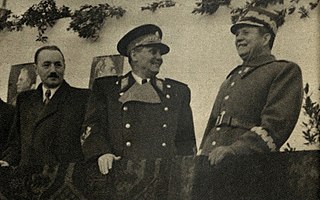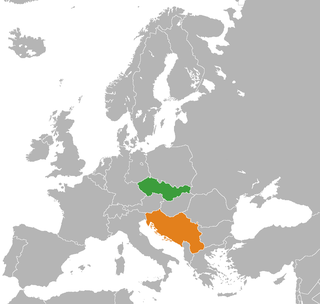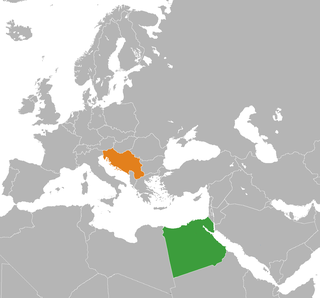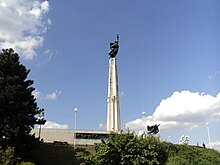
Josip Broz, commonly known as Tito, was a Yugoslav communist revolutionary and politician who served in various positions of national leadership from 1943 until his death in 1980. During World War II, he was the leader of the Yugoslav Partisans, often regarded as the most effective resistance movement in German-occupied Europe. He also served as prime minister from 2 November 1944 to 29 June 1963 and president of the Socialist Federal Republic of Yugoslavia from 14 January 1953 until his death. His political ideology and policies are collectively known as Titoism.

Titoism is a socialist political philosophy most closely associated with Josip Broz Tito during the Cold War. It is characterized by a broad Yugoslav identity, socialist workers' self-management, a political separation from the Soviet Union, and leadership in the Non-Aligned Movement.

The Belgrade declaration is a document signed by President of Yugoslavia Josip Broz Tito and Soviet leader Nikita Khrushchev on 2 June 1955 that brought about a short reconciliation between the two states. Negotiations leading up to the signing of the document took place between 27 May and 2 June.
The Tito–Stalin split or the Soviet–Yugoslav split was the culmination of a conflict between the political leaderships of Yugoslavia and the Soviet Union, under Josip Broz Tito and Joseph Stalin, respectively, in the years following World War II. Although presented by both sides as an ideological dispute, the conflict was as much the product of a geopolitical struggle in the Balkans that also involved Albania, Bulgaria, and the communist insurgency in Greece, which Tito's Yugoslavia supported and the Soviet Union secretly opposed.

Russia–Serbia relations are the bilateral foreign relations between the Russian Federation and the Republic of Serbia. The countries established official diplomatic relations as the Russian Empire and Principality of Serbia in 1816. Russia has an honorary consulate and embassy in Belgrade, and a liaison office to UNMIK, the capital of the disputed territory of Kosovo. Serbia has an embassy in Moscow, an honorary consulate in St. Petersburg and has announced to open a consulate-general in Yekaterinburg.

The Socialist Federal Republic of Yugoslavia was one of the founding members of the Non-Aligned Movement. Its capital, Belgrade, was the host of the First Summit of the Non-Aligned Movement in early September 1961. The city also hosted the Ninth Summit in September 1989.

Czechoslovakia–Yugoslavia relations were historical foreign relations between Czechoslovakia and Yugoslavia, both of which are now-defunct states. Czechoslovakia and the Kingdom of Serbs, Croats and Slovenes were both created as union states of smaller Slavic ethnic groups. Both were created after the dissolution of Austria-Hungary, itself a multinational empire unable to appease its Slavic populations or implement a trialist reform in its final years.

Afghanistan–Yugoslavia relations were historical foreign relations between Afghanistan and now split-up Socialist Federal Republic of Yugoslavia. Both countries were founding member states of the Non-Aligned Movement. Prime Minister of Afghanistan Mohammed Daoud Khan represented the Kingdom of Afghanistan at the 1961 First Conference of Heads of State or Government of the Non-Aligned Movement in Belgrade.

Albania–Yugoslavia relations were historical foreign relations between Albania and now broken up Yugoslavia. With occasional periods of friendly relations or efforts to improve relations, the two countries predominantly maintained cold or openly hostile relations. The period of close relations developed right after the end of World War II when Yugoslavia pushed for socioeconomic integration of Albania into Yugoslavia within the Balkan Federation, but they turned into sharp antagonism after the 1948 Tito–Stalin split.

Poland–Yugoslavia relations were historical foreign relations between Poland and now broken up Yugoslavia.

Egypt–Yugoslavia relations were historical foreign relations between Egypt and now break-up Yugoslavia. Both countries were founding members and prominent participants of the Non-Aligned Movement. While initially marginal, relations between the two Mediterranean countries developed significantly in the aftermath of the Soviet-Yugoslav split of 1948 and the Egyptian revolution of 1952. Belgrade hosted the Non-Aligned movement's first conference for which preparatory meeting took place in Cairo, while Cairo hosted the second conference. While critical of certain aspects of the Camp David Accords Yugoslavia remained major advocate for Egyptian realist approach within the movement, and strongly opposed harsh criticism of Cairo or proposals which questioned country's place within the movement.

Ethiopia–Yugoslavia relations were historical foreign relations between Ethiopia and now split-up Socialist Federal Republic of Yugoslavia. Both countries were among founding members of the Non-Aligned Movement. The first contacts between the two countries were established at the United Nations in 1947 where Yugoslavia supported Ethiopian claims on Eritrea while Ethiopia supported Yugoslav claims over the Free Territory of Trieste. After the 1948, Tito-Stalin split Yugoslavia turned towards the non-bloc countries and two countries opened their embassies in 1955. The formal diplomatic relations were established already in 1952. Emperor Haile Selassie was the first African head of state in official visit to Yugoslavia in 1954.

Norway–Yugoslavia relations were historical foreign relations between Norway and now split-up Yugoslavia.

United States–Yugoslavia relations were the historical foreign relations of the United States with both Kingdom of Yugoslavia and Socialist Federal Republic of Yugoslavia (1945–1992). During the existence of the SFRY, relations oscillated from mutual ignorance, antagonism to close cooperation, and significant direct American engagement. The United States was represented in Yugoslavia by its embassy in Belgrade and consulate general in Zagreb.

Romania–Yugoslavia relations were historical foreign relations between Romania and now broken up Yugoslavia. Relations between Romania and independent South Slavic states developed before creation of Yugoslavia and union of Transylvania with Romania and those relations played prominent role during the Second Balkan War. Relations between the two states were generally friendly and were only occasionally affected by wider alliance policies.

Libya–Yugoslavia relations were historical foreign relations between Libya and now split-up Socialist Federal Republic of Yugoslavia. Two countries established formal diplomatic relations in 1955.

China–Yugoslavia relations were historical foreign relations between China and now split-up Socialist Federal Republic of Yugoslavia. For a long period during the Cold War China was critical towards perceived excessive liberalism, too close cooperation with Western Bloc or market socialism of Yugoslavia, therefore the Chinese communists accused the Yugoslav communists of being revisionists, while the Yugoslav communists accused the Chinese communists of being dogmatics. But, the good relations between both socialist states were restored at the end of the 1960s, and improved even more since the Sino-Albanian rupture occurred, with the trend of improved relations continuing in relations with successor states, particularly Serbia. In the 1980s Deng Xiaoping's foreign policy resembled Yugoslavia's stance of being non-aligned and non-confrontational and with Hu Yaobang’s 1983 appraisal of ‘Josip Tito's principles of independence and equality among all communist parties, and of opposing imperialism, colonialism, and hegemonism’. All six former Yugoslav republics have memoranda of understanding with China on Belt and Road Initiative.

Foreign relations of Yugoslavia were international relations of the interwar Kingdom of Yugoslavia and the Cold War Socialist Federal Republic of Yugoslavia. During its existence, the country was the founding member of numerous multilateral organizations including the United Nations, Non-Aligned Movement, International Monetary Fund, Group of 77, Group of 15, Central European Initiative and the European Broadcasting Union.

United Kingdom–Yugoslavia relations were historical foreign relations between United Kingdom and former Yugoslavia. Relations between United Kingdom and independent South Slavic states developed before creation of Yugoslavia following the decline of the Ottoman Empire.


































